�
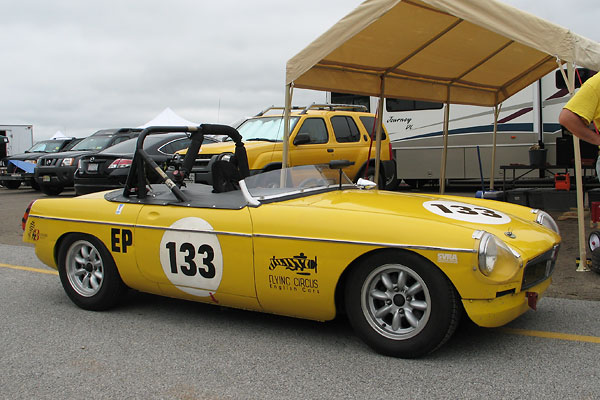
�
Simon Briggs' 1972 MGB Race Car, Number 133
� Owner: Simon Briggs of B-Stinger Racing� � City: Durham, NC
� Model: 1972 MGB
� Built by: B-Stinger Racing Team�
�
B-Stinger Racing
��
The B-Stingers team are a group of friends from the Durham, North Carolina area. BritishV8 �
Magazine readers will likely recognize two of the teams members. Crew Chief Max Fulton �
co-coordinated the 2009 BritishV8 Meet, and also has attended ten of the twelve previous �
annual meets. Max works at Flying Circus English Cars, which is the team's principal sponsor. �
Car owner Simon Briggs works nearby at Apex Vintage Inc., which prepares vintage racecars �
of all makes and types. When he's not working, Simon enjoys driving his small block Chevy �
powered Triumph Stag. The B-Stingers car is usually piloted by Oliver Tolksdorf, with �
back-up and enduro driving shared by Rick Starkweather. The remaining team members are �
Ted Alman, Andy Broughton, Terry Jones, and Zarrel Lambert. �
�
The B-Stingers team began racing in April 2004. Since then, they've grown consistantly �
faster without ever sacrificing reliability. Of twenty races entered, they've started in �
nineteen, and they've finished eighteen. They've raced over 4000 miles without serious �
incident, and they've medalled six times (with one 1st-place and one 2nd-place finish in �
enduros, two 2nd-place finishes in SVRA races, one 2nd-place finish in a VDCA race,and �
one 3rd-place finish in an SVRA race.) Their quickest lap around Virginia International �
Raceway to date was clocked at 2:22.9.�
�
 �
�
�
�
Features and Specifications
�| Engine: | �BMC B-series "18GK" 1.8L engine rebuilt with 0.040" oversize bores (1847cc).�
45DCOE Weber on a Cannon 6" aluminum manifold (part# 99003 801).�
VP18SP camshaft. �
(The initials stand for "Vizard Profile", named for David Vizard, and "Scatter Pattern" respectively.)�
Jacobs "Pro Street Energy Pak" CDI (capacitive discharge ignition) triggered by a Crane electronic ignition �
through a Lucas "gold" coil.�
Jacobs "Ultra Coil".�
Stock oil pump, modified for increased flow.�
Oberg "Tattle Tale" oil filter.�
3 quart Accusump. | �
| Cooling: | �Ron Davis aluminum radiator (part# 1-33B6267, two rows of 1" tubes). �
Spal 10" electric fan.�
16-row oil cooler. | �
| Exhaust: | �PECO header and exhaust system, including muffler. | �
| Transmission: | �MOWOG with Jack Knight SC/CR (straight cut, close-ratio) gear set.�
Borg & Beck heavy duty clutch.�
Early model MGB driveshaft. | �
| Rear Axle: | �a custom rear axle was created by combining the inner section of an �
early model MGB "banjo" axle with the tubes from a later-model MGB �
Salisbury axle. (Salisbury axles came with beefier halfshafts and bearings, �
but banjo axles are lighter and have more suitable gear and differential options.)�
4.1:1 gears and Phantom Grip disc-type limited slip differential. | �
| Front Susp.: | �Raised stub axles.�
(Note: sometimes these are called "dropped spindles".)�
800 lbs/in springs.�
1" anti-sway bar.�
Modified steering arms. | �
| Rear Susp.: | �stock MGB springs, with the two shortest leafs removed.�
Lowering blocks. �
Spax telescoping shock absorbers.�
Custom 9/16" anti-sway bar.�
Custom Panhard rod. | �
| Brakes: | �(master) stock MGB. � (front) stock calipers and rotors. Hawk "Blue" V8-pattern pads. � (rear) stock MGB drum brakes, except with MGB GT (larger diameter) wheel cylinders and Porterfield shoes. | �
| Wheels/Tires: | �Compomotive 14x6 aluminum wheels with Hoosier "Street T.D." P205/60D14 bias ply tires. | �
| Electrical: | �Bosch alternator from a Jaguar.�
(The pulley is larger, so it turns at lower RPM than a stock Lucas/MGB alternator.)�
Gustafson gear reduction starter, provided by Brit-Tek.�
A wet-cell battery is located in the normal location. | �
| Instruments: | �(left to right)�
Voltmeter,�
Sunpro mechanical oil temperature gauge (100-250F), �
SPA Design tachometer (0-9000rpm) with programmable shift light and electronic telltale, �
Smiths oil pressure gauge (0-100psi),�
digital air/fuel mixture gauge,�
Westach dual EGT gauge (700-1700F),�
Sunpro mechanical coolant temperature gauge (100-250F),�
fuel pressure gauge (0-15psi),�
Hobbes hour meter. | �
| Fuel System: | �Fuel Safe eight gallon fuel cell.�
Holley fuel pump.�
Fram HPG-1 filter. �
Holley fuel pressure regulator. | �
| Safety Eqmt: | �five point roll cage.�
Momo Corse "Rookie" driver's seat.�
G-Force five point Camlock safety harness. | �
| Weight: | �1903 pounds wet (without driver) including 36 pounds of lead ballast to meet class requirements. | �
| Racing Class: | �SVRA Group 3 D Production / VDCA Group 3 C Production. | �
Engine Installation
��
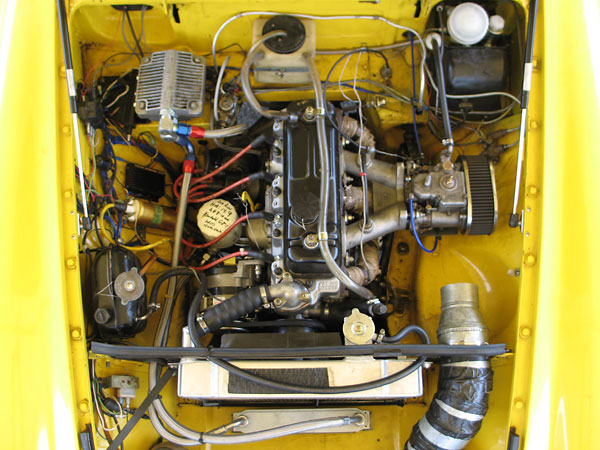
�
BMC B-series "18GK" 1.8L engine rebuilt with 0.040" oversize bores (1847cc).
�
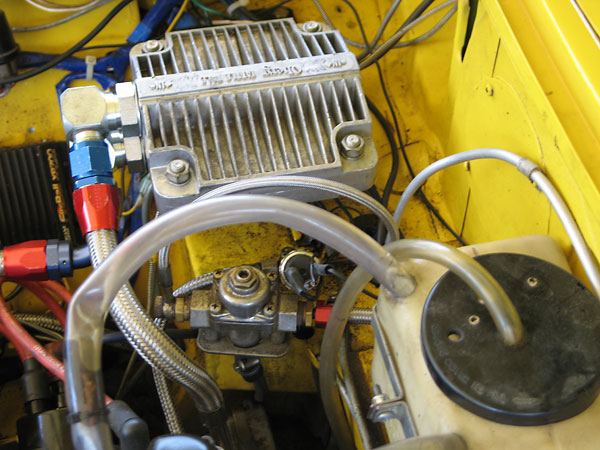
�
Oberg "Tattle Tale" oil filter. Foreground: Holley fuel pressure regulator.
�
Background: Crane XR700 ignition controller.
�
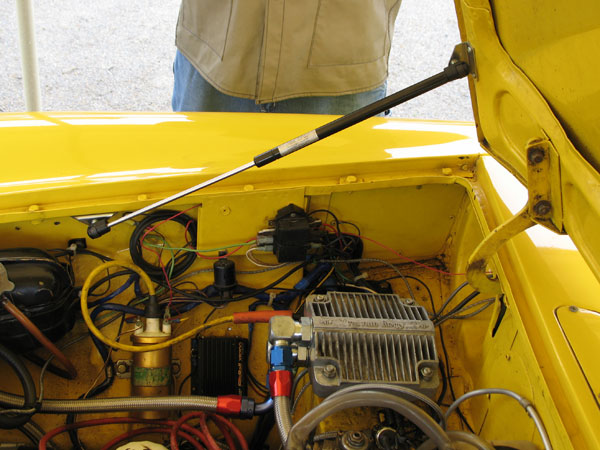
�
Photos on this page show the coil primary lead connected two different ways. This photo (and the next one)
�
show how the car normally races. Max Fulton explains: the Crane ignition system's optical trigger (mounted
�
inside the distributor) signals the Crane XR700 ignition controller, which in turn fires the Lucas gold coil.
�
As shown here, the Lucas coil is connected to a Jacobs sensor. The Jacobs system adjusts for resistance
�
and then fires its own special coil which is mounted on the other side of the firewall. In a pinch, however,
�
they could connect directly from the Lucas coil to the distributor. The Jacobs capacitive discharge ignition
�
system provides desireable spark characteristics, but it's very easy to disconnect if it ever fails.
�
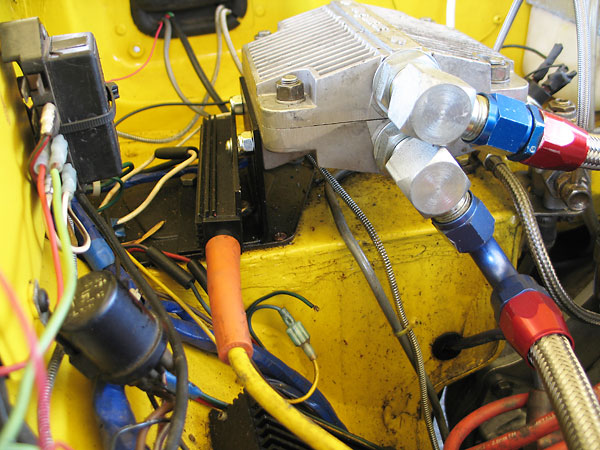
�
Jacobs ingnition sensor.
�
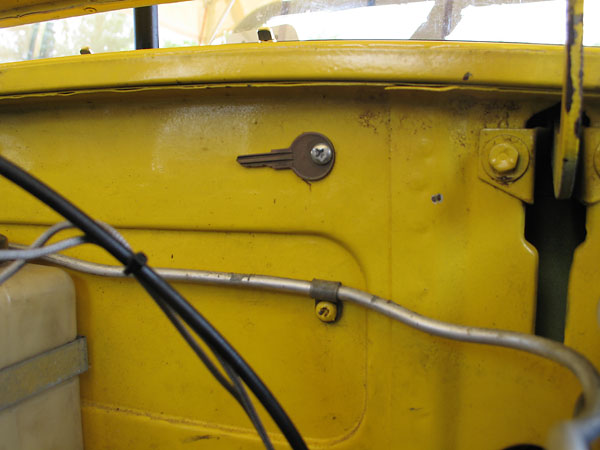
�
MGB's left the factory with a spare key screwed to their firewall. This one is still in place.
�
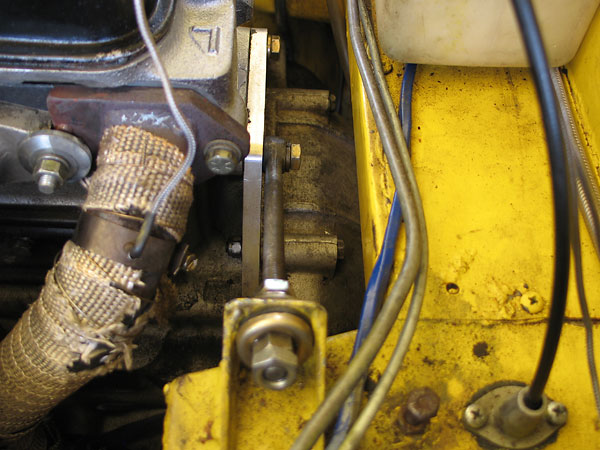
�
Engine steady bar... made from a Jaguar XJ6 alternator bracket.
�
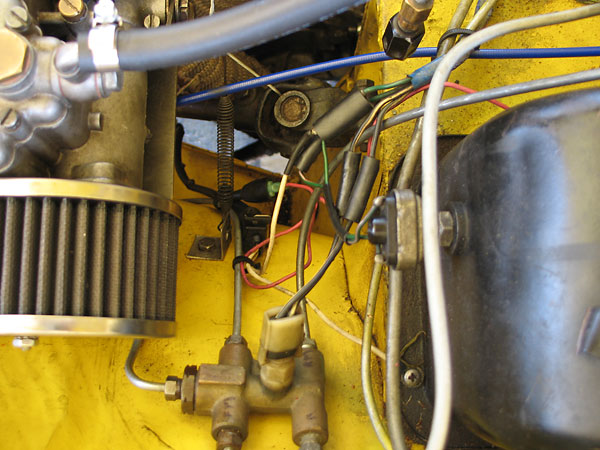
�
�
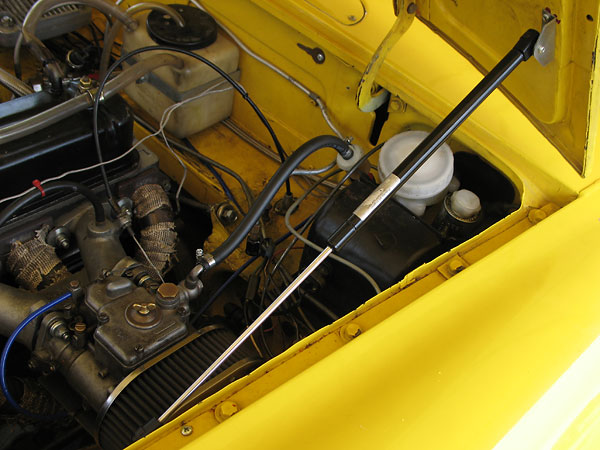
�
Pieces of Eight gas springs.
�
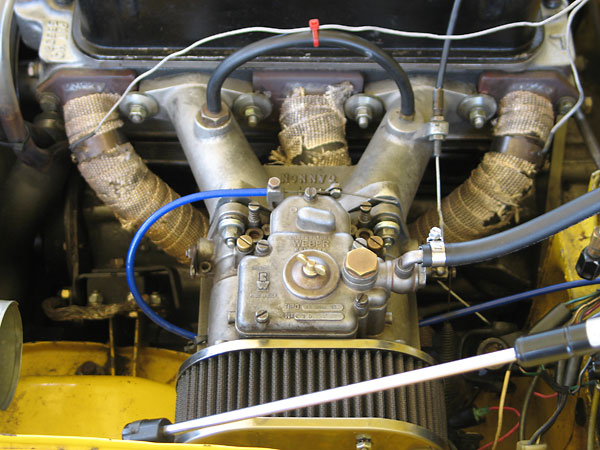
�
45DCOE Weber on a Cannon 6" aluminum manifold (part# 99003 801).
�
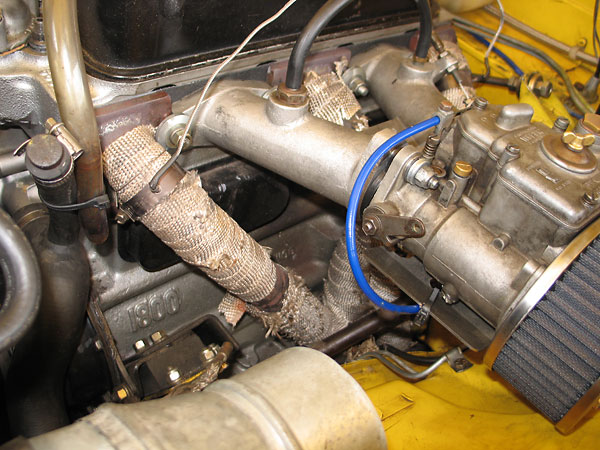
�
Peco exhaust header.
�
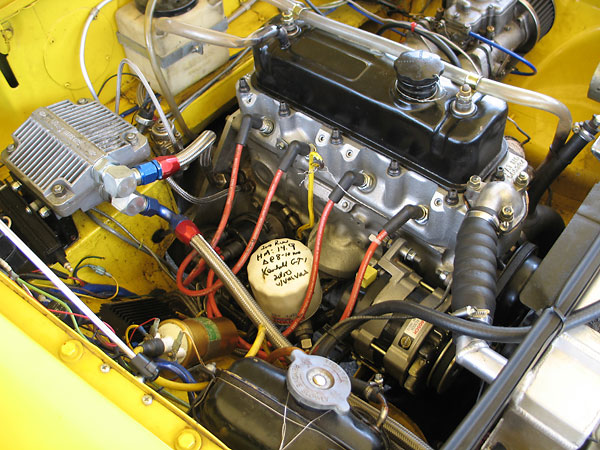
�
�
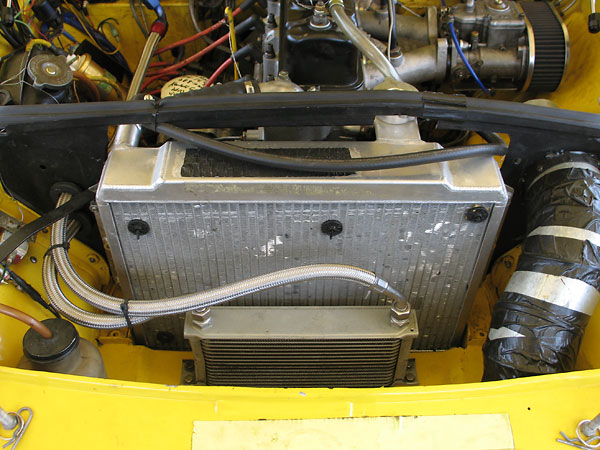
�
Ron Davis aluminum radiator (part# 1-33B6267, two rows of 1" tubes).
�
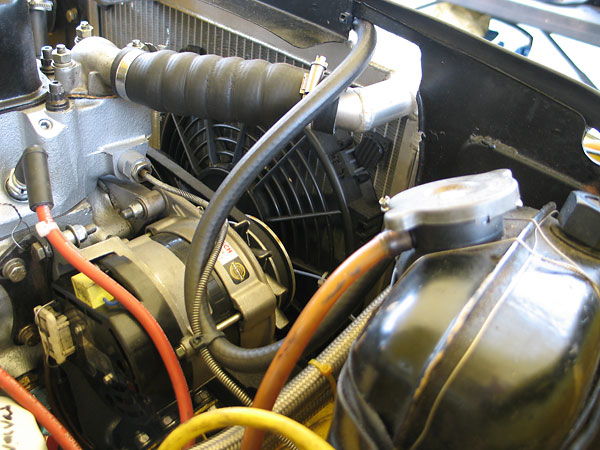
�
Note the relatively large pulley on the Bosch alternator. Behind it: 10" Spal electric fan.
�
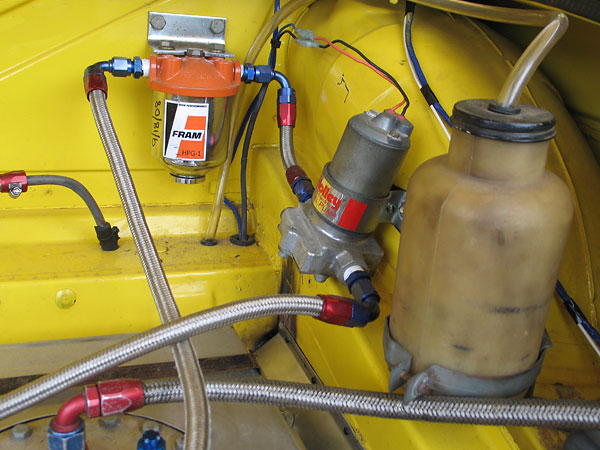
�
Holley fuel pump. Fram HPG-1 filter.
�
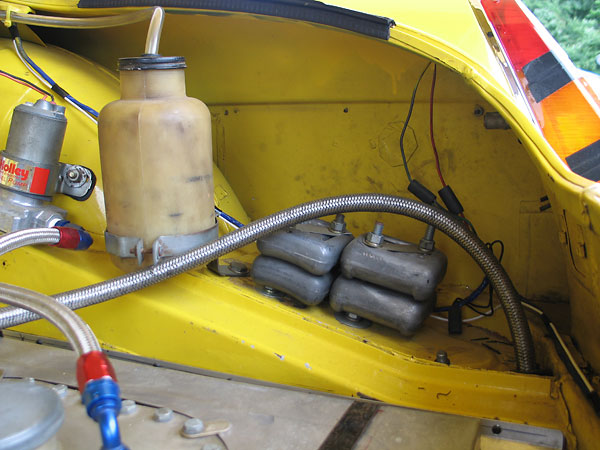
�
36 pounds of lead ballast to meet class requirements.
�
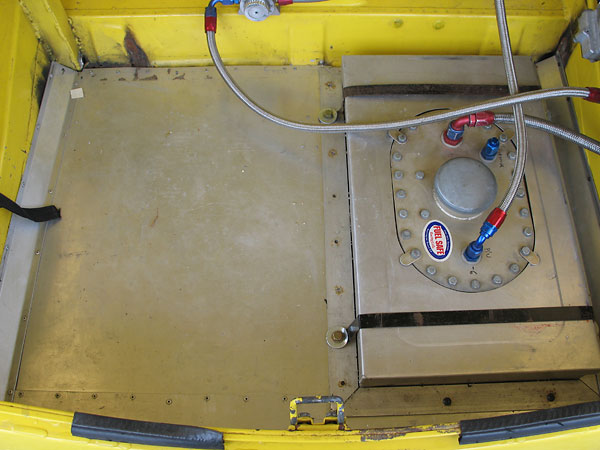
�
Fuel Safe eight gallon fuel cell.
�
�
Front Suspension
��
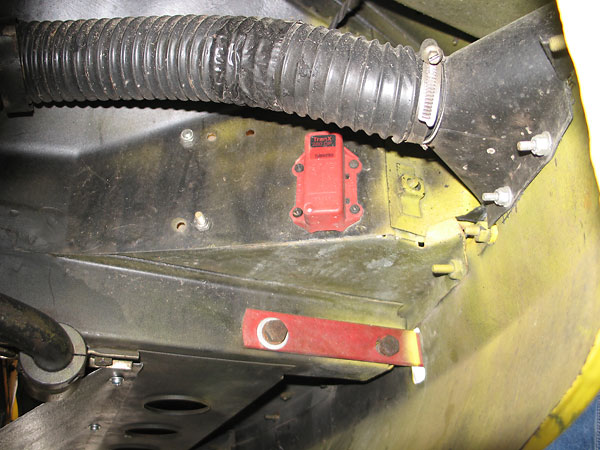
�
Brake cooling duct, a transponder for the track's timing system, and a 1" anti-sway bar.
�
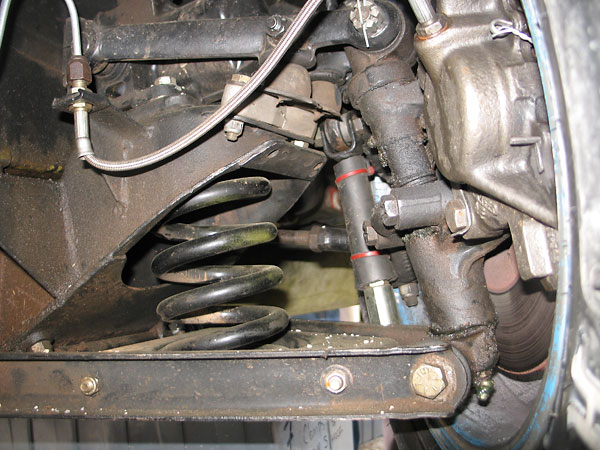
�
These are the Killer Beez version of raised stub axles (dropped spindles) that's available from
�
Targett Motorsport. The top inch of the spindle casting has been cut off, and one inch of new
�
material has been welded-on at the bottom. An unmodified kingpin is used. Unlike another supplier's
�
version, Killer Bees raised stub axles leave the protective grease shields installed and functional.
�
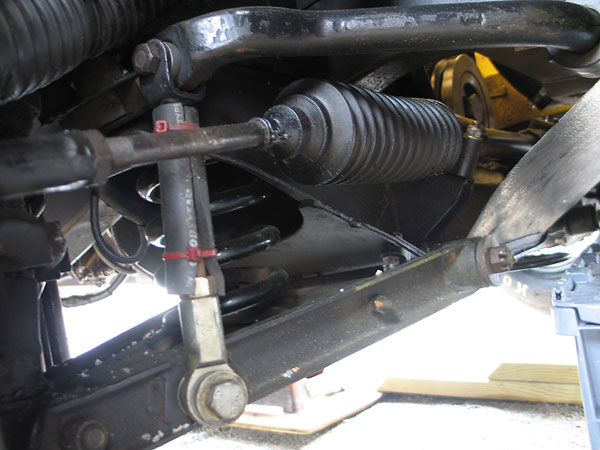
�
Raised stub axles are an alternative to shortening coil springs when lowering a car. In theory,
�
the steering link should stay roughly parallel to the lower control arm, so roll and bump steering
�
effects should be minimized. In practice, the B-Stingers still found it necessary to modify their
�
steering arms to eliminate roll steer. (Don't try this at home!)
�
�
Enjoying this article? www.BritishRaceCar.com is partially funded through generous support from readers like you!
�
To contribute to our operating budget, please click here and follow the instructions.
�
(Suggested contribution is twenty bucks per year. Feel free to give more!)�
Rear Suspension
� �
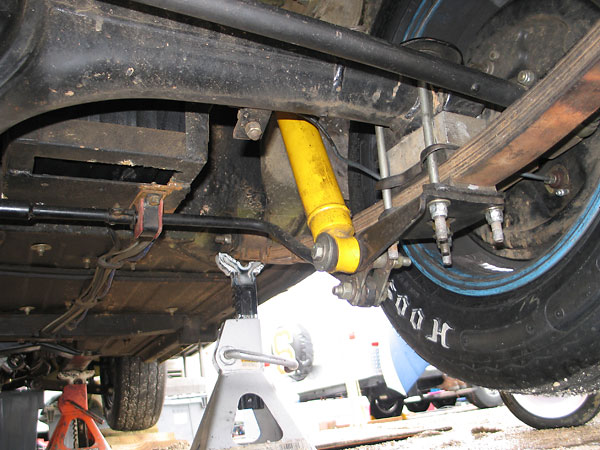
�
The B-Stingers call this a "Briggsbury" rear axle. It combines the inner section of an MG banjo housing
�
(as used on MGA's and early MGB's) with the tubes, bearings and shafts from a Salisbury axle.
�
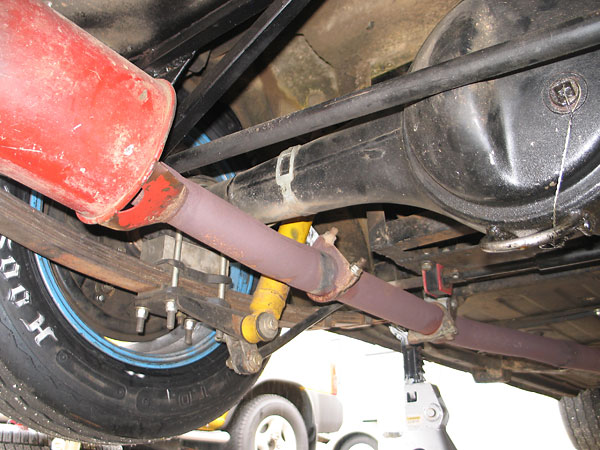
�
To work properly, a Panhard rod must be very stout. This Panhard rod bracket is especially so!
�
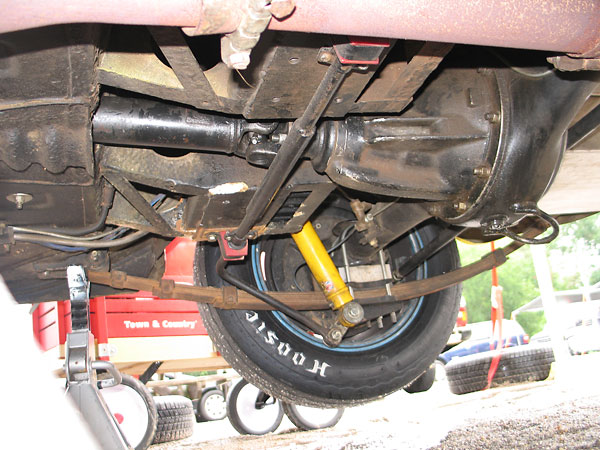
�
The B-Stingers created their own rear anti-sway bar by modifying a chrome-bumper MBG (9/16") front bar.
�
�
Interior
��
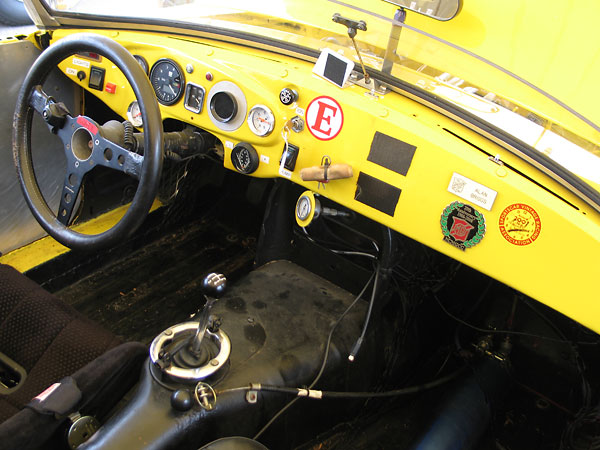
�
�
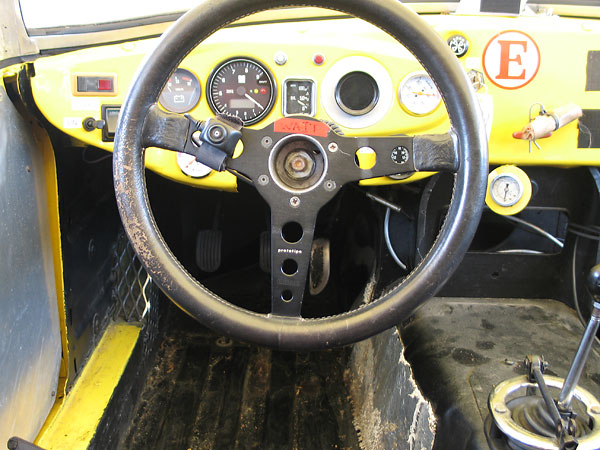
�
Momo "Prototipo" steering wheel. A "push to talk" button for the in-car Simpson radio is on the left spoke.
�
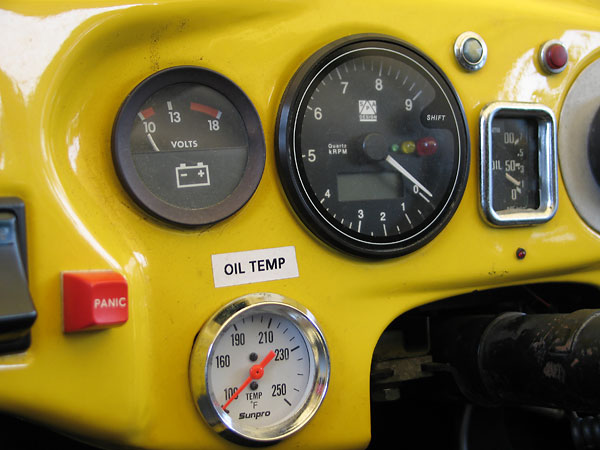
�
Voltmeter, Sunpro oil temp gauge, and SPA Design tach with programmable shift light and telltale.
�
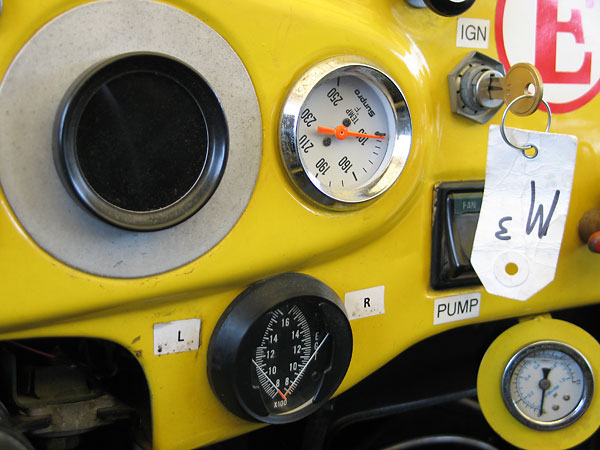
�
(left to right) Digital air/fuel mixture gauge (reads an O2 sensor on the center header pipe), Westach
�
dual EGT gauge (reads sensors on the two outer pipes), Sunpro mechanical coolant temp gauge, and
�
a fuel pressure gauge. The Westach EGT gauge was useful for tuning S.U. carbs, which were previously
�
used, but the air/fuel mixture gauge has made it essentially redundant.
�
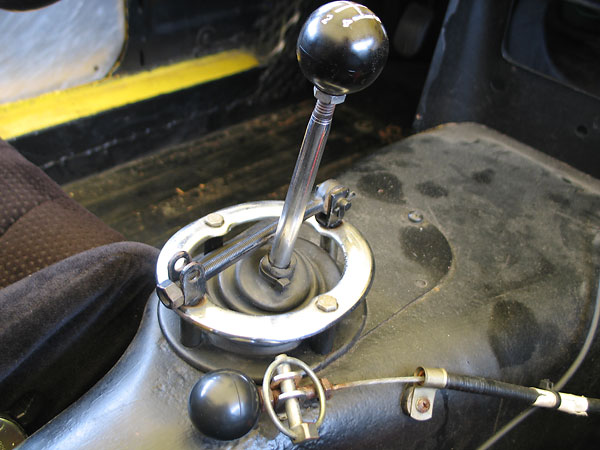
�
Center: this device blocks the reverse shift gate while racing. Foreground: actuator for the Accusump.
�
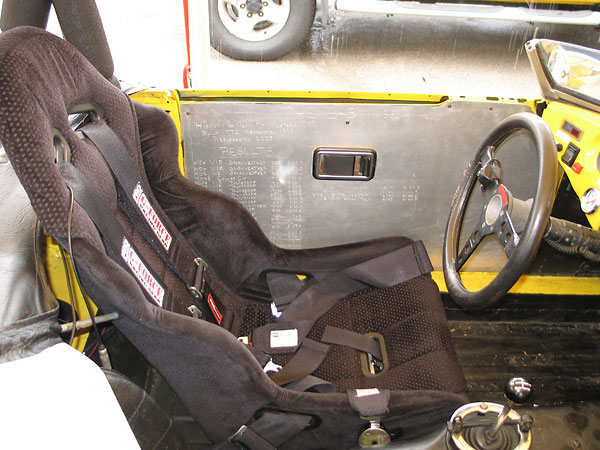
�
Momo Corse "Rookie" driver's seat. G-Force five point Camlock safety harness.
�
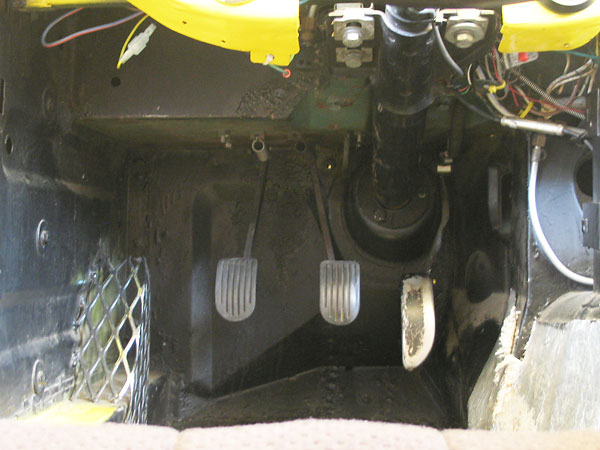
�
Dead pedal (i.e. a place to rest or brace your left foot).
�
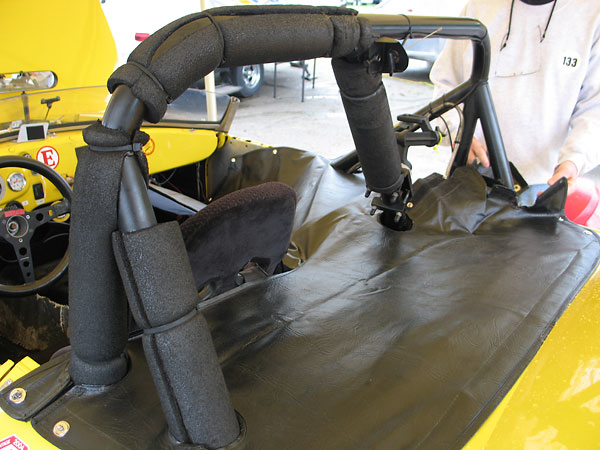
�
Five point roll cage, surrounded by a specially constructed tonneau cover.
�
�
Exterior
��
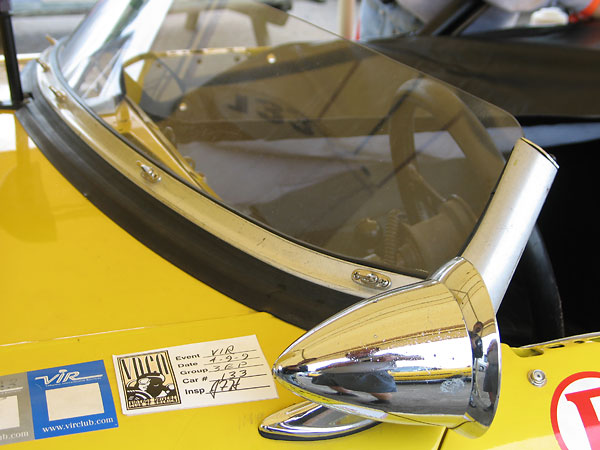
�
Low profile polycarbonate windscreen. The mirror was donated by a Triumph TR6.
�
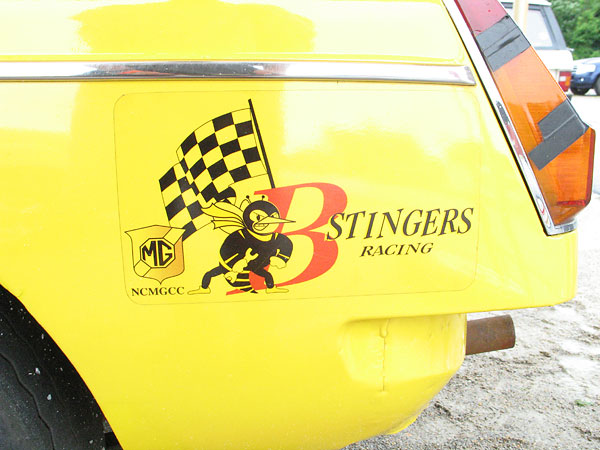
�
B-Stingers Racing (North Carolina MG Car Club).
�
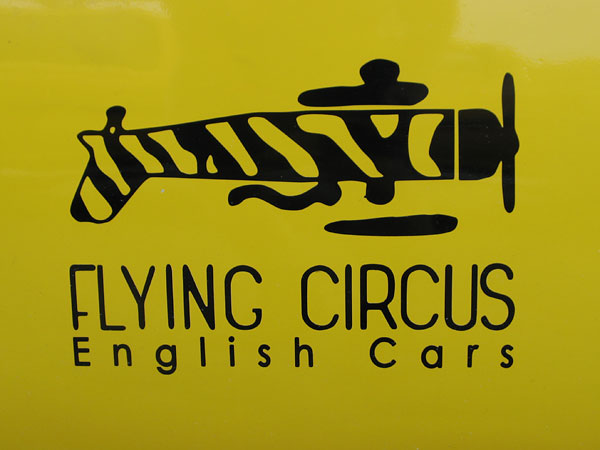
�
Sponsored by: Flying Circus English Cars.
�
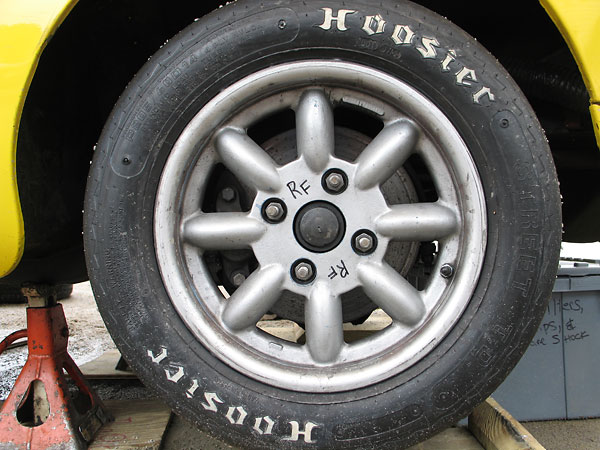
�
Compomotive 14x6 aluminum wheels with Hoosier "Street T.D." P205/60D14 bias ply tires.
�
�
All photos shown here are from June 2009, when we viewed the car at The Heacock Classic Gold Cup at �
Virginia International Raceway. All photos by Curtis Jacobson for BritishRaceCar.com, copyright 2010. �
All rights reserved.
�
| If you liked this article, you'll probably also enjoy these: | �|||||
 | �
Kent Prather 1962 MGA | �
 | �
John Targett 1964 MGB | �
 | �
Marcus Jones 1964 MGB | �
| You're invited to discuss anything you've seen here on The British Racecar Motorsports Forum! | �|||||
�
Notice: all the articles and almost all the photos on BritishRacecar.com are by Curtis Jacobson.
�
(Photos that aren't by Curtis are explicitly credited.) Reproduction without prior written permission is prohibited.
�
Contact us to purchase images or reproduction permission. Higher resolution images are optionally available.
�

 �
�